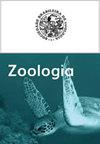巴西动物分类目录:毛翅目(昆虫亚目)、多样性和分布
IF 1.8
4区 生物学
Q4 ZOOLOGY
引用次数: 15
摘要
球虱是一种高度多样化的水生昆虫,特别是在新热带地区,那里有大量的地方性分类群。根据截至2019年8月发表的分类学贡献,巴西共记录了796种球蝇。巴西球虱的分类数据目前在“Catálogo Taxonômico da Fauna do Brasil”网站(CTFB)上开放获取,这是一个包含巴西发生的动物物种分类信息的在线数据库。CTFB的毛翅目包括巴西记录的物种目录和同义词列表,分布在巴西的6个生物群系、12个水文区域和27个政治州(包括联邦区)。数据库不断更新,以包括新发布的数据。本文以巴西CTFB数据库为基础,对巴西球蝇的分类工作进行了综述。全国已描述或记录物种的逐年累积曲线显示出较强的上升趋势,表明可能还有更多的物种有待描述。基于三个地理水平(生物群系、水文区域和州)的球虱物种的存在/缺失,二阶Jackknife估计巴西(以水文区域为统一)至少有1586种,表明我们目前了解巴西球虱动物群的50%左右。巴西生物群落的物种分布表明,大西洋森林最多样化,有490种(298种特有种),其次是亚马逊森林,有255种(101种特有种)。尽管这些数字可能是有偏差的,因为在这两个生物群系中有更密集的收集,大西洋森林中特有的球虱物种的百分比是显着的。基于发病率数据的聚类分析(UPGMA)将其划分为西北盆地和东南盆地两类。尽管这些类群在物种组成上具有较弱的自举支持和较低的相似性,但巴西地虱动物群的这种划分可能与亚马逊-大西洋森林的分离有关,南美洲干燥的对角线在整个进化过程中起着潜在的屏障作用。本文章由计算机程序翻译,如有差异,请以英文原文为准。
Taxonomic Catalog of the Brazilian Fauna: order Trichoptera (Insecta), diversity and distribution
Caddisflies are a highly diverse group of aquatic insects, particularly in the Neotropical region where there is a high number of endemic taxa. Based on taxonomic contributions published until August 2019, a total of 796 caddisfly species have been recorded from Brazil. Taxonomic data about Brazilian caddisflies are currently open access at the “Catálogo Taxonômico da Fauna do Brasil” website (CTFB), an on-line database with taxonomic information on the animal species occurring in Brazil. The order Trichoptera at CTFB includes a catalog of species recorded for the country, with synonymic lists, distribution throughout six biomes, 12 hydrographic regions, and 27 political states (including Federal District) from Brazil. The database is constantly updated to include newly published data. In this study, we reviewed the taxonomic effort on Brazilian caddisflies based on data currently in CTFB database. The accumulation curve of species described or recorded from the country, by year, shows a strong upward trend in last 25 years, indicating that it is possible that there are many more species to be described. Based on presence/absence of caddisfly species at three geographic levels (biomes, hydrographic regions, and states), second order Jackknife estimated at least 1,586 species occurring in Brazil (with hydrographic regions as unities), indicating we currently know about 50% of the Brazilian caddisfly fauna. Species distribution by Brazilian biomes reveals that the Atlantic Forest is the most diverse, with 490 species (298 endemic), followed by the Amazon Forest, with 255 species (101 endemic). Even though these numbers may be biased because there has been more intense collecting in these two biomes, the percentage of endemic caddisfly species in the Atlantic Forest is remarkable. Considering the distribution throughout hydrographic regions, clustering analyses (UPGMA) based on incidence data reveals two groups: northwestern basins and southeastern. Although these groups have weak bootstrap support and low similarity in species composition, this division of Brazilian caddisfly fauna could be related to Amazon-Atlantic Forest disjunction, with the South American dry diagonal acting as a potential barrier throughout evolutionary time.
求助全文
通过发布文献求助,成功后即可免费获取论文全文。
去求助
来源期刊

Zoologia
生物-动物学
自引率
0.00%
发文量
15
期刊介绍:
Zoologia, the scientific journal of the Sociedade Brasileira de Zoologia (SBZ), is an international peer-reviewed, open-access Zoological journal that publishes original research on systematics, evolution, taxonomy, nomenclature, biogeography, morphology, physiology, biology, ecology, symbiosis, conservation, behavior, genetics and allied fields. The journal, formerly known as Revista Brasileira de Zoologia, publishes original articles authored by both members and non-members of the Society. The manuscripts should be written exclusively in English.
 求助内容:
求助内容: 应助结果提醒方式:
应助结果提醒方式:


